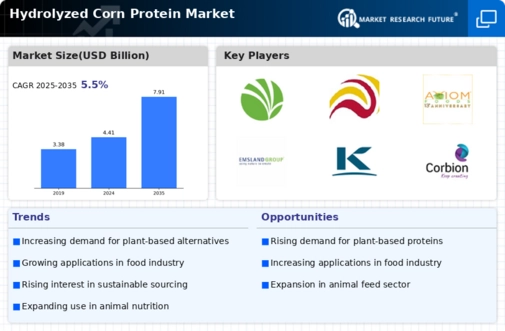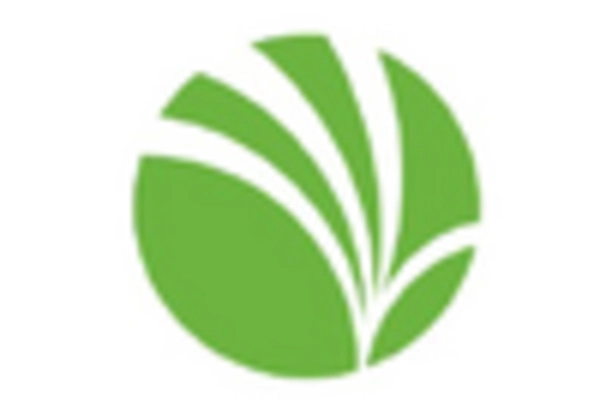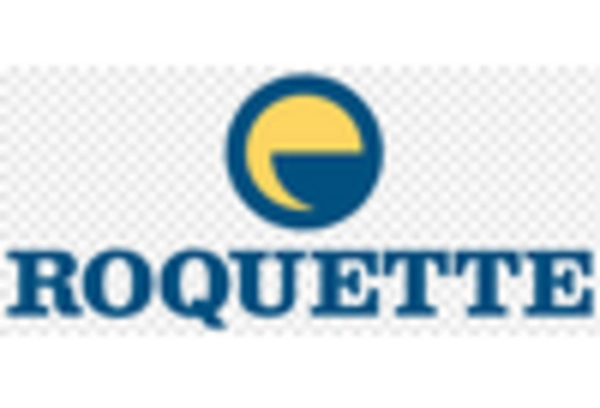Increasing Health Consciousness
The Hydrolyzed Corn Protein Market is experiencing a surge in demand driven by a growing awareness of health and wellness among consumers. As individuals become more health-conscious, they seek protein sources that are not only nutritious but also easily digestible. Hydrolyzed corn protein, known for its high bioavailability, aligns with these consumer preferences. Market data indicates that the protein supplement sector is projected to grow at a compound annual growth rate of approximately 8% over the next five years. This trend suggests that the Hydrolyzed Corn Protein Market could see substantial growth as more consumers incorporate protein into their diets for health benefits.
Sustainability and Environmental Concerns
Sustainability is becoming a pivotal factor influencing consumer choices, particularly in the food sector. The Hydrolyzed Corn Protein Market is benefiting from the shift towards sustainable protein sources. Hydrolyzed corn protein, derived from renewable resources, presents an eco-friendly alternative to animal-based proteins. As consumers increasingly prioritize sustainability, the demand for plant-based proteins is expected to rise significantly. Reports suggest that the plant-based protein market could exceed 30 billion dollars by 2027, indicating a favorable environment for the Hydrolyzed Corn Protein Market to thrive as it aligns with these sustainability goals.
Expansion of Food and Beverage Applications
The versatility of hydrolyzed corn protein is a key driver for its adoption across various food and beverage applications. The Hydrolyzed Corn Protein Market is witnessing increased utilization in products such as protein bars, beverages, and meat alternatives. This expansion is fueled by the rising trend of protein fortification in food products, which is expected to reach a market value of over 20 billion dollars by 2026. As manufacturers seek to enhance the nutritional profile of their offerings, hydrolyzed corn protein serves as an effective ingredient, thereby propelling the growth of the Hydrolyzed Corn Protein Market.
Rising Popularity of Vegan and Vegetarian Diets
The increasing adoption of vegan and vegetarian diets is significantly impacting the Hydrolyzed Corn Protein Market. As more consumers shift towards plant-based lifestyles, the demand for alternative protein sources is on the rise. Hydrolyzed corn protein, being a plant-derived protein, is well-positioned to cater to this growing demographic. Market analysis suggests that the plant-based food market is expected to grow at a rate of 9% annually, which bodes well for the Hydrolyzed Corn Protein Market. This trend indicates a robust opportunity for manufacturers to develop innovative products that appeal to health-conscious and environmentally aware consumers.
Technological Advancements in Protein Processing
Advancements in protein processing technologies are playing a crucial role in enhancing the quality and functionality of hydrolyzed corn protein. The Hydrolyzed Corn Protein Market is witnessing innovations that improve the extraction and hydrolysis processes, resulting in higher purity and better solubility. These technological improvements not only enhance product quality but also reduce production costs, making hydrolyzed corn protein more accessible to manufacturers. As the industry embraces these advancements, the market is likely to expand, with projections indicating a potential growth rate of 7% annually over the next few years.


















Leave a Comment